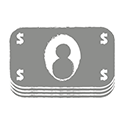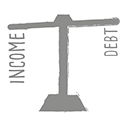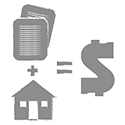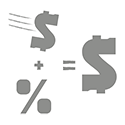A Crash Course: Understanding Credit9/30/2015My dad likes to tell the story of me asking him if he would "buy" me a credit card for my birthday when I was younger. Even as a little girl I had a vague understanding of credit; the magic kind. Back then, credit was some kind of fantastic card that got you stuff and that was kind of a big deal for an 8-9 year old girl who wanted nothing more than to play dolls and dress-up all day. Having grown up quite a bit, I now have a better understanding of credit. So, what is credit exactly?
In essence credit is a tool that involves two parties, a lender/creditor and a borrower. Money or principal (the amount borrowed or the amount still owed on a loan, separate from interest), is loaned to the borrower with the understanding that it will be paid back, usually with interest.
Common types of credit include secured, unsecured, revolving, and installment.
 Secured Credit:
Secured Credit: With secured credit, the creditor guarantees that what is borrowed will be paid back by putting a lien on an asset that the borrower owns. This lien entitles the lender to take the asset if the borrower does not live up to the terms of his/her credit agreement. Car loans, mortgages, and home equity loans are examples of secured credit.
 Unsecured Credit:
Unsecured Credit: Unsecured credit is the borrower simply giving his/her word to the creditor that he/she will repay what is borrowed. Types of unsecured credit are credit cards, medical bills, and utility bills.
 Revolving Credit:
Revolving Credit: Revolving credit involves the creditor approving the borrower for a set amount of money (credit limit) that the borrower can access at any time. In return, the borrower must pay the creditor a minimum amount on his/her outstanding balance each month. Credit cards and line of credit loans are examples of revolving credit.
 Unsecured Credit:
Unsecured Credit: With installment credit, the borrower is loaned a certain amount of money for a set period of time. In turn, the borrower must repay what is borrowed by making a number of fixed or installment payments (e.g. monthly). Installment credit is typically used for large purchases with loan terms varying from a few months to many years. Monthly payment amounts are often set for the life of the loan and interest rates are normally lower than those of a credit card. Some examples of installment credit are car loans and mortgages.
As mentioned earlier, what is borrowed on credit is usually paid back with interest. The APR or annual percentage rate is a determining factor in how much interest the borrower will have to pay back on the amount borrowed. It tells the borrower the cost of the loan per year, including any fees or additional costs associated with the loan. High or low APR and/or an interest rate on a loan is determined by the borrower's credit score.
Collateral, Capital, Capacity, Character, and Conditions are the Five C's of Credit. These five things are what lenders look at when evaluating a borrower.
 Collateral:
Collateral: This is an asset of value (e.g. a house or a car) that the borrower offers the lender to secure a loan. If the borrower is unable to meet the terms of his/her credit agreement, the lender/creditor has the right to seize the collateral to recover their losses (i.e. lien). Loans that are secured by collateral typically have a lower interest rate than unsecured loans because they offer the lender some form of security should the loan not be paid.
 Captial:
Captial: This refers to financial assets of value such as personal property, investments, or savings that can be used or sold by the lender should the borrower not be able to pay on his/her loan.
 Capacity:
Capacity: A lender's main concern is whether the borrower will be able to repay his/her loan. By comparing the borrower's income against his/her recurring debts, the lender is able to measure the borrower's ability or capacity to meet his/her credit agreement. A pattern of rising income and steady employment history gives creditors more confidence that the borrower's debt will be paid.
 Character:
Character: Is the borrower trustworthy? Does the borrower pay his/her bills on time? What is the borrower's credit score?
 Conditions:
Conditions: Loan conditions, such as the interest rate and amount of principal, can influence the creditor's desire to finance the borrower.
Now that we've discussed what lenders look for when weighing the decision to extend credit to a potential borrower, let's talk about what the borrower should be on the lookout for.
Some things to look at when applying for credit are the type of fees involved, the loan term, and the grace period (whether there is one and how long it is).
 Loan Term:
Loan Term: When applying for installment credit, such as a car loan or mortgage, the length of time the borrower has to pay off the loan is considered the loan term. Generally speaking, the longer the loan term, the lower the borrower's monthly payment will be. However, the cost of using credit increases because the borrower will be paying interest over a longer period of time.
 Annual Fee:
Annual Fee: This is a yearly charge that the borrower pays for the privilege of using credit. Annual fees are usually charged by credit card companies, especially for high rewards or exclusive cards.
 Origination Fee:
Origination Fee: This type of fee is usually connected with home loans. It is a fee that is charged for setting up the loan.
 Over-the-limit Fee:
Over-the-limit Fee: When using credit cards, typically an over-the-limit fee is charged when the borrower exceeds his/her credit limit.
 Late Fee:
Late Fee: When a credit card or loan payment is made after the due date a late fee the borrower is charged a late fee. If there is a grace period, late fees can be avoided in the condition that the borrower makes his/her payment before his/her grace period ends.
 Grace Period:
Grace Period: This is the length of time the borrower has before interest starts accumulating or a late fee is charged.
 Universal Default:
Universal Default: Commonly practiced by credit card companies. Having a universal default clause in the credit agreement means the creditor can increase the borrower's interest rate if he/she makes a late payment. The creditor may do this, even if that late payment is made to a different creditor for a different type of payment, like a phone bill or a car loan.
 Finance Charge:
Finance Charge: A finance charge is a fee for the use of credit or the extension of existing credit. It is often a combined cost, including the cost of carrying the debt, related transaction fees, late fees, and account maintenance fees. (For example, if the borrower only makes the minimum payment each month on the balance of his/her credit card and he/she made a late payment on the card the total of both would be the finance charge.)
Having this knowledge on hand can only help you, as a borrower, to better understand credit terminology and how to make credit work for you.
« Return to "BluePrint"
Go to main navigation

